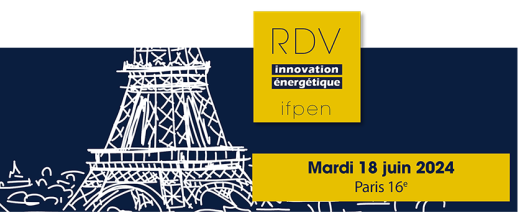Main Points to Remember
Decarbonizing the automotive sector requires an approach that promotes technological neutrality, combining electrification, hydrogen, and bioenergies. Battery electric vehicles (BEVs) are considered the optimal solution for most applications, but infrastructure and cost challenges remain. Collaboration between industry, research, and public authorities will be essential to meet emission reduction targets.
Gaétan Monnier, Director of the Mobility Business Unit, IFPEN
Gaétan Monnier provided a detailed overview of the context and emissions reduction objectives in the automotive sector:
- 2030 targets: -55% for passenger cars, -50% for light commercial vehicles (compared to 2021 levels).
- 2030–2040: progressive targets for trucks (-45% by 2030, -65% by 2035, -90% by 2040 compared to 2019).
Several European countries (Norway, the Netherlands, Austria, Sweden, Slovenia, Denmark, Ireland, Scotland) plan to phase out internal combustion engines between 2025 and 2032. Some companies are also announcing fully electric lineups by 2030–2040.
Electrification is not yet widespread in road freight, and non-electric zero-emission fuels remain alternatives.
The electric passenger vehicle market has grown, but 2023 data shows:
- 1 in 6 cars sold in Europe was electric, with a strong dominance of high-end models (SUVs);
- One-third of vehicles sold in France came from Asia, and only 10% of new EVs sold in France were domestically produced.
Key challenges include expanding the supply of smaller EVs, improving heavy-duty EV range, charging infrastructure, price adjustment, and managing import duties. The 2026 policy review is also a critical topic.
Philippe Schulz, Director of Upstream Technology Partnerships, Ampère
Philippe Schulz presented the strategy and investments of Ampère, Renault’s dedicated EV business unit.
Ampère represents an industrial and technological revolution addressing societal sustainability, European industrial sovereignty, and financial challenges. The automotive industry has already invested €270 billion in electrification.
Renault, with production sites in France like Cléon and the ElectriCity hub in the north, has made major investments while aiming to make EVs more accessible and affordable.
The industry must now push beyond the current 18% EV market share toward 50%.
Reducing battery costs is key, requiring continuous tech innovation, especially in battery chemistry and energy integration in vehicles. Technological flexibility, including hydrogen internal combustion engines, could support zero-emission targets.
Marc Lejeune, Director of Business Intelligence, Renault Trucks
Marc Lejeune offered a comprehensive analysis of solutions to decarbonize freight, which accounts for one-third of vehicle fuel consumption.
- Battery-electric trucks:
- Pros: high energy efficiency, lower mid-term costs, better carbon footprint, reduction in NOx and noise;
- Cons: critical mineral availability, grid infrastructure, operational constraints for carriers, and higher upfront cost.
- Hydrogen:
- Relevant where batteries are not viable;
- Challenges: low availability of green/blue hydrogen, poor energy efficiency for both fuel cells and hydrogen engines, high costs, less favorable carbon footprint;
- Trade-offs between faster refueling / longer range vs. higher costs remain unresolved.
- Bioenergies (biomethane, biodiesel):
- Constraints: limited availability, often prioritized for power generation or marine/aviation use, high costs;
- E-diesel: seen as too costly—Renault Trucks chooses not to invest.
Battery-electric is considered optimal for most freight transport use cases, with hydrogen and bioenergies as complementary options for specific situations.
Mathieu Soulas, Director of New Mobilities, TotalEnergies
Mathieu Soulas discussed charging infrastructure, focusing on operational aspects for both light-duty vehicles (LDVs) and heavy-duty vehicles (HDVs).
LDV energy distribution has shifted over 20 years from public gas stations to electric charging points, now 70% private and 30% public. Public charging is divided into three categories:
• Urban (mainly via public tenders),
• Long-distance (fast-charging hubs),
• Interurban.
Charging station challenges include: safety, reliability, cybersecurity, user experience, and economic viability—massive investments face low utilization rates.
These infrastructures, initially subsidy-driven, are now attracting private investment and competition. Active in Western Europe and China, TotalEnergies aims to cover all LDV infrastructure segments.
For HDVs, the shift is toward alternative fuels like biogas. In electric mobility, key issues include energy efficiency, cost, lack of incentives for HDVs, and the behavioral shift required from drivers and fleet managers.
António Pires da Cruz, Program Manager, IFPEN
António Pires da Cruz presented IFP Energies nouvelles’ (IFPEN) commitment to decarbonization and carbon neutrality by 2050.
As a public research and innovation center, IFPEN’s mission is to advise public authorities on technological choices and develop job- and value-creating innovations for France and Europe. Technological neutrality is a core principle.
To meet the 2050 neutrality goals, in alignment with the Green Deal and regulatory frameworks for maritime and aviation, IFPEN develops:
• Electrification solutions: electric motors, batteries, power electronics;
• Hydrogen engines and fuel cells;
• Low-carbon fuels: first- and second-generation biofuels from biomass and recycled carbon, offering competitive carbon balances, including for ICE vehicles as a transition strategy.
These developments require legislative and fiscal support.
With expertise dating back to the 1980s, IFPEN provides technologies for advanced biofuels (biodiesel, bioethanol, biokerosene) and synthetic e-fuels with favorable carbon performance.
Another decarbonization focus is mobility digitalization: collecting and analyzing data to improve driving behavior, vehicle usage, and support decision-making.






